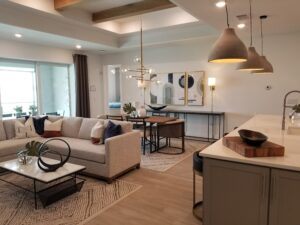Learn how to stage your home for sale and attract potential buyers with these expert tips and insights. From enhancing curb appeal to creating inviting interiors, we have you covered!
Selling a home can be an overwhelming process, but with the right preparation and staging techniques, you can increase its appeal to potential buyers. Properly staging your home can significantly impact its market value and make a lasting impression on prospective buyers. In this comprehensive guide, we will explore tried-and-tested strategies to stage your home for sale effectively. Whether you’re a first-time seller or a seasoned real estate veteran, these expert tips will help you showcase your property in the best possible light.
How to Stage Your Home for Sale
1. Understanding the Importance of Staging
Before diving into the nitty-gritty of home staging, it’s crucial to understand why it matters. Staging allows you to highlight the property’s unique features, create an emotional connection with buyers, and maximize its market value. Properly staged homes often sell faster and at higher prices, making it a worthwhile investment for any seller.
2. Decluttering and Depersonalizing Your Space
A clutter-free environment is essential when showcasing your home to potential buyers. Remove personal items, excess furniture, and any items that could distract buyers from envisioning themselves living in the space. A clean and depersonalized home allows buyers to imagine their own belongings in the property.
3. Enhancing Curb Appeal
First impressions matter, and the exterior of your home is the first thing buyers will see. Enhance your home’s curb appeal by maintaining a well-kept lawn, trimming bushes, and adding fresh flowers. Repainting the front door and updating the house numbers can also make a significant impact.
4. Repairs and Maintenance
Make sure your home is in top-notch condition by addressing any necessary repairs and maintenance tasks. Fix leaky faucets, squeaky doors, and cracked tiles. A well-maintained home gives buyers the confidence that the property has been cared for.
5. Neutralizing Color Schemes
While bold colors may suit your personal taste, they might not appeal to everyone. Opt for neutral color schemes on walls and furniture to create a more universally appealing atmosphere. Neutral colors also help buyers envision their own style in the space.
6. Optimizing Furniture Arrangement
Arrange furniture to create an open and inviting layout. Be mindful of traffic flow and ensure that rooms feel spacious. Strategic furniture placement can highlight the property’s best features and make it more appealing to potential buyers.
7. Letting in Natural Light
Ample natural light can make a significant difference in how your home is perceived. Remove heavy drapes and open blinds or curtains to let the sunshine in. A well-lit home feels welcoming and spacious.
8. Adding Stylish Home Decor
Strategically placed home decor items can enhance the overall ambiance of your property. Consider adding fresh flowers, decorative cushions, and tasteful artwork. However, avoid overdoing it; a cluttered decor can be distracting.
9. Showcasing Functional Spaces
If you have unused or awkward spaces in your home, transform them into functional areas. A small nook can become a cozy reading corner, or an empty corner can be turned into a mini-home office. Demonstrating the potential of every space helps buyers see the possibilities.
10. Appealing to the Senses
Staging isn’t just about how your home looks; it’s also about appealing to the senses. Consider playing soft background music, having a fresh scent in the air, and offering refreshments during open houses. These small touches create a memorable experience for buyers.
11. Highlighting Energy-Efficient Features
If your home has energy-efficient features, such as solar panels or a smart thermostat, be sure to highlight them. Today’s buyers often value eco-friendly options that can save them money in the long run.
12. Creating Inviting Outdoor Spaces
Don’t neglect your outdoor areas when staging your home. Set up a cozy seating area on the patio or deck to showcase the potential for outdoor entertaining and relaxation.
13. Tackling Pet Odors and Allergens
If you have pets, be aware of potential pet odors and allergens that could turn off buyers. Deep clean carpets, upholstery, and pet areas to ensure a fresh and allergen-free environment.
14. Organizing Closets and Storage Spaces
Buyers appreciate ample storage space. Organize your closets, cabinets, and storage areas to showcase their full potential. A cluttered storage space can give the impression of insufficient storage, which is a turn-off for many buyers.
15. Addressing Flooring Concerns
If your home has worn or damaged flooring, consider repairing or replacing it. Flooring is a significant selling point for buyers, and pristine floors can elevate the overall appeal of your property.
16. Incorporating Mirrors
Strategically placed mirrors can create the illusion of more space and enhance natural light reflection. Mirrors are a cost-effective way to make rooms appear larger and brighter.
17. Staging Your Home for Online Listings
In today’s digital age, most buyers start their search for a home online. Ensure that your home looks appealing in photos by staging it for online listings. Capture the best angles and highlight key features.
18. Utilizing Seasonal Staging
If you’re selling your home during a specific season, consider incorporating seasonal decor to create a warm and inviting atmosphere. For example, during the winter, you can add cozy blankets and rugs, while in the summer, fresh flowers can brighten up the space.
19. Seeking Professional Staging Services
If you’re unsure about staging or want expert assistance, consider hiring a professional staging service. Staging professionals have experience in maximizing a home’s appeal and can provide valuable insights.
20. Virtual Staging Options
In some cases, virtual staging can be a cost-effective alternative to physical staging. Virtual staging uses digital technology to add furniture and decor to listing photos, giving buyers a sense of the property’s potential.
21. Hosting Virtual Tours
With the rise of remote home buying, hosting virtual tours has become increasingly important. Use technology to give potential buyers a comprehensive view of your home, highlighting its key features.
22. Collecting Positive Testimonials
If you’ve previously staged your home and received positive feedback from visitors, consider collecting testimonials. Positive testimonials can boost buyer confidence and provide social proof of your home’s appeal.
23. Understanding Local Market Trends
Stay informed about the local real estate market trends. Understanding what buyers in your area are looking for can help you tailor your staging efforts accordingly.
24. Setting the Right Price
Staging your home is essential, but pricing it correctly is equally important. Work with a real estate agent to determine the right price based on market conditions and comparable properties.
25. How to Stage Your Home for Sale: Conclusion
Staging your home for sale is a powerful tool to attract buyers and secure a successful sale. By understanding the importance of staging, decluttering, enhancing curb appeal, and utilizing strategic home decor, you can create a compelling and inviting atmosphere that appeals to potential buyers. Don’t forget to consider virtual staging and hosting virtual tours to accommodate remote buyers. Remember, a well-staged home not only sells faster but can also fetch a higher price, making it a worthwhile investment in your selling journey.
FAQs
Q: How much does professional home staging cost?
A: The cost of professional home staging can vary depending on factors such as the size of your home, the extent of staging required, and the location. On average, home staging can cost anywhere from a few hundred to a few thousand dollars. However, consider it as an investment that can yield a higher return when your home sells.
Q: Can I stage my home myself, or do I need to hire a professional?
A: While you can certainly stage your home yourself, hiring a professional staging service can provide you with expert insights and create a more polished look. A professional stager has experience in showcasing homes effectively and can make your property stand out in the market.
Q: Is virtual staging as effective as physical staging?
A: Virtual staging can be a cost-effective alternative to physical staging, especially if you have budget constraints. It can give buyers a sense of how the space can be used and provide an idea of its potential. However, physical staging offers a more immersive experience and can be more impactful in person.
Q: How long does the home staging process typically take?
A: The duration of the home staging process depends on the size of your home and the amount of work required. In some cases, it can take a few days to a week to complete the staging process. Consult with a professional stager to get a better estimate for your specific property.
Q: Will staging guarantee a quick sale?
A: While staging significantly increases the likelihood of a quick sale, it’s not a guarantee. Other factors, such as market conditions, pricing, and the location of your home, also play a role in how quickly it sells. However, staging does give you a competitive edge in attracting buyers.
Q: Should I stage my home even if it’s in excellent condition?
A: Yes, staging is beneficial even if your home is in excellent condition. Staging helps showcase the potential of the property, allows buyers to envision themselves living there, and makes a positive impact on their overall impression of the home.
Conclusion:
Staging your home for sale is an art that requires careful planning and attention to detail. By following the expert tips outlined in this guide, you can create an inviting and appealing environment that captivates potential buyers. Remember to declutter and depersonalize your space, enhance curb appeal, and utilize strategic furniture arrangements and home decor. Consider incorporating virtual staging and hosting virtual tours to accommodate today’s tech-savvy buyers. By staging your home effectively, you’ll increase its market value and create a lasting impression on potential buyers, ultimately leading to a successful sale.


